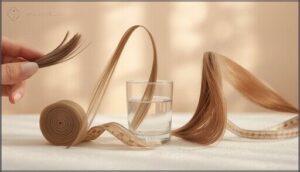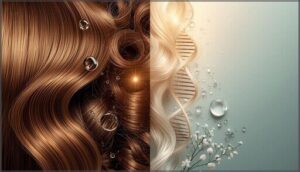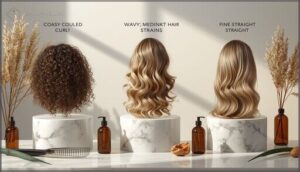This site is supported by our readers. We may earn a commission, at no cost to you, if you purchase through links.

Your hair has been trying to tell you something—and it’s not what you think. That frizz on humid days, the way products seem to sit on top instead of sinking in, or how your curls fall flat by noon aren’t random quirks. They’re your hair’s language, revealing its unique structure and needs.
Hair texture analysis for styling decodes these signals by examining strand thickness, porosity, and shape patterns that determine how your hair behaves. Once you understand your hair’s texture profile, you can match products and techniques to its actual characteristics instead of fighting against them.
This knowledge transforms frustrating trial-and-error into a targeted approach that brings out your hair’s natural strengths.
Table Of Contents
Key Takeaways
- Understanding your hair’s texture—strand thickness, porosity, and elasticity—lets you choose products and techniques that work with your hair’s natural characteristics instead of fighting them through endless trial and error.
- Texture analysis reveals three distinct attributes: strand thickness (fine to coarse), curl pattern (straight to coily), and density (strands per square inch), each requiring different product formulations and styling approaches.
- Your hair’s porosity determines how it absorbs moisture and products—low porosity needs lightweight, water-based formulas while high porosity craves intense hydration to lock in moisture and prevent damage.
- Genetics set your baseline texture, but environmental factors like UV exposure, chemical treatments, hormones, and diet can permanently alter your hair’s structure, making regular texture reassessment every six to twelve months essential for maintaining optimal hair health.
What is Hair Texture Analysis?
Hair texture analysis is the process of examining your hair’s unique physical characteristics to understand how it behaves and what it needs. When you know your texture, you can make smarter choices about products, tools, and techniques that actually work for your hair.
Let’s break down what texture analysis involves and why it matters for your styling routine.
Defining Hair Texture Analysis
Hair texture analysis is your roadmap to understanding the thickness of individual strands—whether they’re fine, medium, or coarse. Unlike hair density, which counts strands per scalp area, or hair type like curly versus straight, texture examines fiber cross-section and shape. Age-related changes can thin these fibers over time, making analysis essential for mastering your hair’s unique properties and structure.
In criminal investigations, hair analysis can provide useful information.
Purpose and Benefits for Styling
Understanding your strand thickness unlocks game-changing styling precision and damage prevention. Hair texture analysis helps you choose hair care products that work with—not against—your natural characteristics. Here’s what you gain:
- Custom styling techniques that respect your hair’s limits while maximizing versatility increase
- Product optimization preventing buildup and boosting manageability
- Enhanced client satisfaction through predictable, flattering results
That’s the foundation for confident hair styling. Understanding your hair’s texture also reveals insights into your hair’s health.
Differences Between Texture, Type, and Density
Many confuse these three hair attributes, but they’re distinct. Hair texture refers to strand thickness—fine, medium, or coarse. Hair type describes your curl pattern, from straight to coily. Hair density measures scalp visibility through strand count per square inch. Mixing them up derails product choices and styling strategies. Recognizing each attribute separately allows for custom approaches that actually work for your unique combination.
| Attribute | What It Measures |
|---|---|
| Texture | Strand thickness and diameter |
| Type | Curl pattern and wave shape |
| Density | Number of strands per area |
| Texture Feel | Silky (fine) to sturdy (coarse) |
| Density Test | Ponytail circumference measurement |
Methods for Analyzing Hair Texture
You don’t need fancy equipment or a salon appointment to analyze your hair texture—you can start right now with your own hands and eyes.
From simple at-home tests to sophisticated digital tools, there are several reliable ways to assess your hair’s unique characteristics.
Let’s walk through the most practical methods you can use to understand your texture, porosity, and overall hair health.
Visual and Manual Assessment Techniques
You can assess your hair texture right at home with simple, hands-on methods that deliver reliable results. Visual classification and tactile assessment form the foundation of hair texture analysis, helping you understand your unique hair type, density, and porosity.
- Strand comparison: Hold a single hair against sewing thread to determine if your texture is fine, medium, or coarse
- Elasticity testing: Gently stretch a wet strand to check if it returns to its original length without breaking
- Porosity assessment: Drop a clean hair in water—floating indicates low porosity, sinking reveals high porosity
- Ponytail circumference: Measure your ponytail’s thickness to gauge overall hair density and texture strength
Digital and AI Hair Analysis Tools
In your quest for mastery, digital hair analysis tools and AI Frizzy Hair Analyzer apps step in with surgical precision. Diagnostic technologies like individual hair analysis tools and devices take the guesswork out, boasting AI accuracy for real-time results.
Market adoption is surging, thanks to styling benefits, rapid assessments, and future innovations that promise even more individual, actionable insights for every hair journey.
Measuring Porosity, Elasticity, and Density
Precision matters in hair texture analysis—you’ll want the right measurement techniques. Porosity Measurement Methods reveal how your strands absorb moisture. Elasticity Testing shows hair’s stretch and strength. Density Analytics tracks how many hairs grow per square inch. Each test, from float tests to microscopy, impacts the styling outcome and helps you personalize your approach.
- Porosity Measurement Methods
- Elasticity Testing
- Density Analytics
- Moisture absorption
- Styling Impact
Key Factors Affecting Hair Texture
Regarding hair texture, there’s more at play than just what you see in the mirror. A mix of internal and external factors can change the way your hair feels and behaves.
Here’s what shapes your unique texture.
Genetic Influences on Texture
Think genetics aren’t shaping your hair texture? Think again. The curve, coil, or strength in every strand traces back to gene variants and dominance patterns that run in your family tree.
Heritability estimates for hair type, from keratin to curl, stay high—meaning key genes and rare genetic syndromes set the stage for your hair texture analysis and styling decisions.
Environmental and Chemical Impacts
Your hair doesn’t exist in a vacuum—UV radiation, pollution effects, and chemical damage reshape its texture daily. Combined exposure to sun and pollutants accelerates protein loss and weakens cuticles faster than either alone.
Chemical treatments, heat damage, and humidity influence add up, causing hair breakage and brittleness. Even styling products with high alcohol content dehydrate strands, making hair styling choices essential for preserving what genetics gave you.
Role of Hormones, Diet, and Health
Your hormonal imbalance doesn’t just affect your mood—it reshapes your hair texture from the inside out. Thyroid impact and autoimmune effects alter hair density and growth cycles, while dietary deficiencies in protein and iron compromise hair health and porosity.
Nutritional support through balanced eating helps counteract these changes, giving you stronger strands that respond better to styling.
How Texture Analysis Guides Styling Choices
Once you understand your hair’s texture, porosity, and density, you can make smarter decisions about how you style and care for it. This knowledge takes the guesswork out of choosing products and techniques that actually work with your hair instead of against it.
Let’s look at how texture analysis translates into practical styling choices that protect your hair and help you achieve the looks you want.
Product Selection by Texture and Porosity
Understanding hair texture analysis and hair porosity transforms your hair care product selection. Fine hair thrives with lightweight formulas that won’t weigh down strands, while coarse hair needs rich emollients for proper product absorption.
Your porosity levels determine ingredient efficacy—low porosity requires water-based products, whereas high porosity hair craves intense moisture to retain hydration and optimize absorption.
Adapting Styling Techniques for Each Texture
Once you’ve matched the right products to your texture, it’s time to adapt how you actually style. Curly hair techniques often involve finger coiling and applying products while wet for definition. Wavy hair methods work best with lighter application and the prayer hands technique. Fine hair styling needs volumizing sprays and lower heat, while coarse hair styling requires layered cuts and smoothing products. Porosity considerations matter here too—low porosity hair responds well to the LOC method and minimal manipulation.
- Apply styling products to curly hair while still wet, working in sections for even distribution
- Use the prayer hands technique for wavy hair to clump waves without creating stiffness
- Keep heat tools around 300°F for fine hair and switch your part frequently for added volume
- Choose layered cuts like shags or long bobs to reduce bulk in thick, coarse hair
- Match your styling gel and technique to your porosity level to maintain hold without dryness
Protective and Damage-Minimizing Styles
Beyond styling techniques, the real power move is choosing protective styling that works with your hair texture. Style installation matters—braids, twists, and wigs shield textured hair from daily manipulation when done with proper tension control.
Keep styles 2-4 weeks max to maintain moisture retention and scalp health. Your texture analysis tells you which protective styles prevent hair damage while supporting growth.
Personalized Hair Care Based on Texture Analysis
Once you understand your hair’s texture, porosity, and elasticity, you can craft a care routine that actually works with what you’ve got instead of against it. This isn’t about following generic advice—it’s about translating your texture analysis into daily habits that prevent damage and bring out your hair’s best qualities.
Here’s how to build an individual approach that keeps your hair healthy and makes styling easier.
Building a Routine for Your Texture
Your hair texture analysis reveals exactly which hair products and styling techniques will work for you. Start with texture-specific cleansing—fine hair needs lightweight formulas, while coarse strands require rich moisture.
Build your hair care routine by layering products strategically: cleanser, conditioner, leave-in treatment. Maintain moisture balance through deep conditioning sessions, and don’t skip scalp health maintenance.
Protective styling reduces daily manipulation while keeping your texture thriving.
Preventing Breakage and Enhancing Health
Your hair texture analysis reveals the breakage triggers you’ve been missing. Heat damage, tight hairstyles, and nutrient gaps weaken your strands—but strategic hair damage prevention changes that.
Layer hydration strategies with protein treatments, prioritize scalp health through gentle styling techniques, and schedule regular trims. Coconut oil can reduce surface roughness by 30%, strengthening your hair.
Smart hair care today means fewer broken ends tomorrow.
Embracing Natural Texture for Styling Confidence
Confidence transforms when you honor your natural texture instead of fighting it. Hair texture analysis reveals your unique curl pattern, guiding you toward styling empowerment and texture self-acceptance.
True confidence comes from embracing your natural texture, not fighting it
Your path to natural beauty includes:
- Selecting hydration products matched to your porosity level
- Learning damage-free styling techniques for your specific texture categories
- Finding community support through natural hair groups
- Celebrating cultural pride in your authentic texture
Approximately 95% of people embracing their natural hair report feeling accepted socially—your texture is your strength.
Frequently Asked Questions (FAQs)
Can hair texture change permanently over time?
Yes, your hair texture change over time can absolutely stick around permanently. Chemical treatments, genetic shifts, hormonal changes, and aging all alter hair structure in lasting ways. Bioactive texture changes show promise for controlled, permanent modifications too.
How does water hardness affect different textures?
Water hardness deposits minerals on your hair, causing texture damage through buildup. Curly, high-porosity strands struggle most—moisture absorption drops, frizz spikes.
Mineral buildup wrecks product efficacy and triggers scalp irritation.
Water softeners help restore hair structure and moisture balance.
What tools work best for fine hair?
The lightest hair demands the heaviest care. For fine hair, you’ll want ceramic tools with adjustable heat settings between 260°F-325°F, plus ionic dryers under 2200 watts to reduce damage while styling effectively.
Do scalp conditions influence hair texture appearance?
Absolutely. Scalp conditions like seborrheic dermatitis, scalp inflammation, and microbiome disruption directly affect hair texture and hair appearance.
Follicle damage from sebum imbalance or compromised nutrient delivery can make strands brittle, limp, or inconsistent.
How often should you reassess your texture?
You should reassess your hair texture every six to twelve months to accommodate aging effects, treatment impact, and lifestyle changes.
Professional advice suggests seasonal reassessment, especially after chemical treatments or significant health shifts affecting hair care needs.
Conclusion
Knowledge is power, but only when you use it. Hair texture analysis for styling gives you the blueprint—now it’s yours to apply.
Start with one small shift: swap a product, adjust your technique, or embrace a style that works with your strands instead of against them.
Your hair’s been speaking this whole time. You’ve learned the language. The real transformation happens when you listen and let that understanding guide every choice you make moving forward.
- https://joelcma.com/blog/understanding-hair-texture/
- https://www.ogleschool.edu/blog/hair-texture-differences-with-hairstyling-and-haircutting/
- https://stablemicrosystems.com/blog/2023/giving-hair-a-new-texture/
- https://www.harpersbazaar.com/uk/beauty/hair/a44254061/texture-gap-type-4-hair-report/
- https://entirelyhealth.com/lifestyle/wellness/is-hair-texture-determined-by-genetics/









